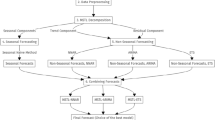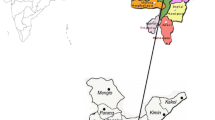Abstract
This article proposed a new time series forecasting model based on neutrosophic set (NS) theory and particle swarm optimization (PSO) algorithm. The proposed model initiated with the representation of time series dataset into NS using three different memberships of NS, i.e., truth-membership, indeterminacy-membership and falsity-membership. This NS representation of time series was referred to as neutrosophic time series (NTS). It was observed that the forecasting accuracy of the proposed model was highly relied on the optimal selection of the universe of discourse of time series dataset. In this study, this problem was resolved by using the PSO algorithm. The proposed model was verified and validated with three different datasets that included the university enrollments dataset of Alabama, TAIFEX index and TSEC weighted index. Experimental results showed that the proposed model outperformed existing benchmark models with average forecasting error rates of 0.80%, 0.015% and 0.90% for the university enrollments, TAIFEX and TSEC, respectively.





Similar content being viewed by others
References
Aladag CH, Yolcu U, Egrioglu E, Dalar AZ (2012) A new time invariant fuzzy time series forecasting method based on particle swarm optimization. Appl Soft Comput 12(10):3291–3299
Atanassov KT (1986) Intuitionistic fuzzy sets. Fuzzy Sets Syst 20(1):87–96
Avazbeigi M, Doulabi SHH, Karimi B (2010) Choosing the appropriate order in fuzzy time series: a new N-factor fuzzy time series for prediction of the auto industry production. Expert Syst Appl 37(8):5630–5639
Bai E, Wong WK, Chu WC, Xia M, Pan F (2011) A heuristic time-invariant model for fuzzy time series forecasting. Expert Syst Appl 38(3):2701–2707
Cai X, zhi Gao X, Xue Y, (2016) Improved bat algorithm with optimal forage strategy and random disturbance strategy. Int J Bio Inspired Comput 8(4):205–214
Cao L, Xu L, Goodman ED (2019) A collaboration-based particle swarm optimizer for global optimization problems. Int J Mach Learn Cybern 10(6):1279–1300
Chen SM (1996) Forecasting enrollments based on fuzzy time series. Fuzzy Sets Syst 81:311–319
Chen SM, Chung NY (2006) Forecasting enrollments using high-order fuzzy time series and genetic algorithms. Int J Intell Syst 21(5):485–501
Chen SM, Tanuwijaya K (2011) Fuzzy forecasting based on high-order fuzzy logical relationships and automatic clustering techniques. Expert Syst Appli 38(12):15,425–15,437
Cheng C, Chang J, Yeh C (2006) Entropy-based and trapezoid fuzzification-based fuzzy time series approaches for forecasting IT project cost. Technol Forecas Soc Change 73:524–542
Cheng CH, Cheng GW, Wang JW (2008) Multi-attribute fuzzy time series method based on fuzzy clustering. Expert Syst Appl 34:1235–1242
Cheng CH, Wei LY, Liu JW, Chen TL (2013) OWA-based ANFIS model for TAIEX forecasting. Econ Model 30:442–448
Eberhart R, Kennedy J (1995) A new optimizer using particle swarm theory. In: Proceedings of the Sixth International Symposium on Micro Machine and Human Science, Nagoya, pp 39–43
Eberhart R, Shi Y (2001) Particle swarm optimization: developments, applications and resources. In: In Proceedings of the IEEE international conference on evolutionary computation, Brisbane, Australia, pp 591–600
Eshtay M, Faris H, Obeid N (2019) Metaheuristic-based extreme learning machines: a review of design formulations and applications. Int J Mach Learn Cybern 10(6):1543–1561
Gangwar SS, Kumar S (2012) Partitions based computational method for high-order fuzzy time series forecasting. Expert Syst Appl 39(15):12,158–12,164
Gupta C, Jain A, Tayal DK, Castillo O (2018) ClusFuDE: forecasting low dimensional numerical data using an improved method based on automatic clustering, fuzzy relationships and differential evolution. Eng Appl Artif Intell 71:175–189
Huarng K (2001) Effective lengths of intervals to improve forecasting in fuzzy time series. Fuzzy Sets Syst 123(3):387–394
Huarng KH, Yu THK (2012) Modeling fuzzy time series with multiple observations. Int J Innov Comput Inf Control 8(10(B)):7415–7426
Huarng KH, Yu THK, Hsu YW (2007) A multivariate heuristic model for fuzzy time-series forecasting. IEEE Trans Syst Man Cybern Part B (Cybern) 37(4):836–846
Jiang P, Dong Q, Li P, Lian L (2017) A novel high-order weighted fuzzy time series model and its application in nonlinear time series prediction. Appl Soft Comput 55:44–62
Joshi BP, Kumar S (2012) Intuitionistic fuzzy sets based method for fuzzy time series forecasting. Cybern Syst 43(1):34–47
Kuo IH, Horng SJ, Kao TW, Lin TL, Lee CL, Pan Y (2009) An improved method for forecasting enrollments based on fuzzy time series and particle swarm optimization. Expert Syst Appl 36(3, Part 2):6108–6117
Kuo IH, Horng SJ, Chen YH, Run RS, Kao TW, Chen RJ, Lai JL, Lin TL (2010) Forecasting TAIFEX based on fuzzy time series and particle swarm optimization. Expert Syst Appl 37(2):1494–1502
Lee HS, Chou MT (2004) Fuzzy forecasting based on fuzzy time series. Int J Comput Math 81(7):781–789
Lee LW, Wang LH, Chen SM, Leu YH (2006) Handling forecasting problems based on two-factors high-order fuzzy time series. IEEE Trans Fuzzy Syst 14:468–477
Lee LW, Wang LH, Chen SM (2008) Temperature prediction and TAIFEX forecasting based on high-order fuzzy logical relationships and genetic simulated annealing techniques. Expert Syst Appl 34(1):328–336
Lin TL, Horng SJ, Kao TW, Chen YH, Run RS, Chen RJ, Lai JL, Kuo IH (2010) An efficient job-shop scheduling algorithm based on particle swarm optimization. Expert Syst Appl 37(3):2629–2636
Liu HT (2007) An improved fuzzy time series forecasting method using trapezoidal fuzzy numbers. Fuzzy Optim Decis Mak 6:63–80
Majumdar P (2015) Neutrosophic sets and its applications to decision making. In: Acharjya DP, Dehuri S, Sanyal S (eds) Computational intelligence for big data analysis: frontier advances and applications. Springer, pp 97–115
Qiu W, Liu X, Li H (2011) A generalized method for forecasting based on fuzzy time series. Expert Syst Appl 38(8):10,446–10,453
Radmehr F, Gharneh NS (2012) Forecasting method based on high order fuzzy time series and simulated annealing technique. S Afr J Ind Eng 23(2):176–190
Richman JS, Moorman JR (2000) Physiological time-series analysis using approximate entropy and sample entropy. Am J Physiol Heart Circ Physiol 278(6):H2039–H2049
Singh P (2015) Applications of soft computing in time series forecasting: simulation and modeling techniques, vol 330. Springer, Berlin
Singh P (2017) A brief review of modeling approaches based on fuzzy time series. Int J Mach Learn Cybern 8(2):397–420
Singh P, Borah B (2013) An efficient time series forecasting model based on fuzzy time series. Eng Appl Artif Intell 26(10):2443–2457
Singh P, Borah B (2014a) An effective neural network and fuzzy time series-based hybridized model to handle forecasting problems of two factors. Knowl Inf Syst 38(3):669–690
Singh P, Borah B (2014b) Forecasting stock index price based on M-factors fuzzy time series and particle swarm optimization. Int J Approx Reason 55(3):812–833
Singh P, Dhiman G (2018) A hybrid fuzzy time series forecasting model based on granular computing and bio-inspired optimization approaches. J Comput Sci 27:370–385
Singh P, Rabadiya K, (2018) Information classification, visualization and decision-making: A neutrosophic set theory based approach. In: Proceedings of (2018) IEEE International Conference on Systems, Man, and Cybernetics (SMC 2018). IEEE, Miyazaki
Singh P, Dhiman G, Kaur A (2018) A quantum approach for time series data based on graph and Schrödinger equations methods. Mod Phys Lett A 33(35):1850,208–1850,231
Smarandache F (1999) A unifying field in logics, neutrosophy: neutrosophic probability. American Research Press, Set and Logic
Song Q, Chissom BS (1993) Forecasting enrollments with fuzzy time series—part I. Fuzzy Sets Syst 54(1):1–9
Sullivan J, Woodall WH (1994) A comparison of fuzzy forecasting and markov modeling. Fuzzy Sets Syst 64(3):279–293
Wang H, Smarandache F, Zhang Y, Sunderraman R (2005) Single valued neutrosophic sets. In: Proceedings of 10th International Conference on Fuzzy Theory and Technology, Salt Lake City
Wang NY, Chen SM (2009) Temperature prediction and TAIFEX forecasting based on automatic clustering techniques and two-factors high-order fuzzy time series. Expert Syst Appl 36:2143–2154
Wei LY, Chen TL, Ho TH (2011) A hybrid model based on adaptive-network-based fuzzy inference system to forecast Taiwan stock market. Expert Syst Appl 38(11):13,625–13,631
Wong WK, Bai E, Chu AW (2010) Adaptive time-variant models for fuzzy-time-series forecasting. IEEE Trans Syst Man Cybern Part B Cybern 40(6):1531–1542
Yu THK, Huarng KH (2008) A bivariate fuzzy time series model to forecast the TAIEX. Expert Syst Appl 34(4):2945–2952
Yu THK, Huarng KH (2010) A neural network-based fuzzy time series model to improve forecasting. Expert Syst Appl 37(4):3366–3372
Zadeh LA (1965) Fuzzy sets. Inf Control 8(3):338–353
Zhang M, Wang H, Cui Z, Chen J (2018) Hybrid multi-objective cuckoo search with dynamical local search. Memet Comput 10(2):199–208
Author information
Authors and Affiliations
Corresponding author
Additional information
Publisher's Note
Springer Nature remains neutral with regard to jurisdictional claims in published maps and institutional affiliations.
Rights and permissions
About this article
Cite this article
Singh, P. A novel hybrid time series forecasting model based on neutrosophic-PSO approach. Int. J. Mach. Learn. & Cyber. 11, 1643–1658 (2020). https://doi.org/10.1007/s13042-020-01064-z
Received:
Accepted:
Published:
Issue Date:
DOI: https://doi.org/10.1007/s13042-020-01064-z




